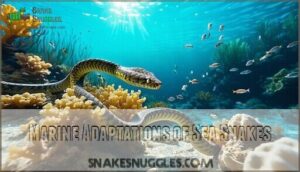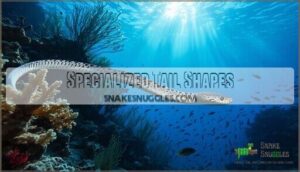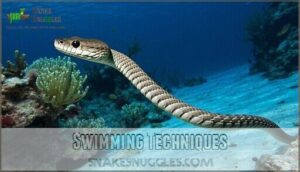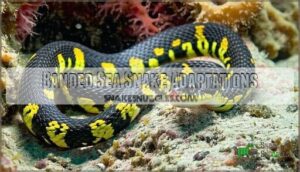This site is supported by our readers. We may earn a commission, at no cost to you, if you purchase through links.

These serpents pack three-finger toxin genes that make their venom up to ten times deadlier than cobras.
They’ve mastered ocean life through skin breathing, absorbing 20% of their oxygen directly through specialized scales.
Salt glands behind their eyes work like tiny desalination plants, filtering seawater so they don’t dehydrate.
Their paddle-shaped tails and streamlined bodies cut through water like living torpedoes.
Visual pigments adapted for underwater hunting let them spot prey in murky depths.
The evolutionary arms race that shaped these adaptations reveals surprising survival strategies.
Table Of Contents
- Key Takeaways
- Sea Snake Toxins
- Marine Adaptations of Sea Snakes
- Swimming Adaptations in Sea Snakes
- Unique Adaptations of Sea Snakes
- Banded Sea Snake Adaptations
- Frequently Asked Questions (FAQs)
- What adaptations do sea snakes have for life in the ocean?
- What toxins do sea snakes have?
- How have the bodies of sea snakes adapted to help them swim?
- What are the adaptations of the banded sea snake?
- How do sea snakes protect themselves from predators?
- Can sea snakes survive in freshwater environments?
- What is the average lifespan of a sea snake?
- Do sea snakes have any natural predators in the ocean?
- Can sea snakes be found in all tropical ocean regions?
- How do sea snakes survive extreme ocean pressure?
- Conclusion
Key Takeaways
- You’ll discover that sea snake venoms contain specialized three-finger toxins that are up to ten times more potent than cobra venom, making them nature’s most efficient underwater killers through millions of years of evolutionary refinement.
- You can observe how sea snakes breathe through their skin, absorbing up to 20% of their oxygen directly through specialized scales during extended underwater hunts that can last up to two hours.
- You’ll find that sea snakes have evolved salt glands behind their eyes that work like miniature desalination plants, filtering excess salt from seawater so they can drink ocean water without poisoning themselves.
- You can see how their paddle-shaped tails and streamlined bodies with overlapping scales create a hydrodynamic design that cuts through water like living torpedoes, enabling precise hunting in coral reefs and shallow marine environments.
Sea Snake Toxins
You’ll encounter sea snake venoms that pack neurotoxins and myotoxins specifically evolved for marine prey capture.
These biochemically streamlined venom systems target nerve and muscle receptors with lethal precision, making them among nature’s most efficient underwater predators with lethal precision.
Nature’s deadliest marine predators deliver biochemical precision that turns seawater into a hunting ground of lethal efficiency.
Venom Systems
In the context of sea snake venom systems, you’re looking at nature’s most refined underwater weapons.
These marine toxins pack a lethal punch through specialized fang structure and precise venom delivery mechanisms.
Sea snake venom differs dramatically from terrestrial species, containing unique neurotoxins that target marine prey with deadly efficiency.
Here’s what makes these venom systems so remarkable:
- Venom composition includes three-finger toxins and phospholipase A2 enzymes specifically adapted for marine environments
- Toxin evolution has fine-tuned these compounds over millions of years for maximum prey capture efficiency
- Venomous species show incredible variability in potency levels between different populations and individuals
- Venom research reveals these systems are biochemically simpler yet more potent than land snake venoms
- Marine toxins work synergistically to cause rapid paralysis in fish and other aquatic prey
The study of venom evolution provides valuable insights into the complex mechanisms behind these deadly venom systems.
Three-finger Toxin Genes
Three-finger toxin genes drive sea snake venom’s deadly power through complex molecular mechanisms.
You’ll find these genes create venom variability across species, with gene expression patterns shaping adaptive traits for marine life.
Toxin evolution occurs through genetic mutations that enhance prey capture efficiency.
Venomous sea snakes rely on these threefinger toxin genes for survival in ocean environments, making marine toxins exceptionally potent through ongoing venom research discoveries.
Gene Expression Toxin Evolution
Evolution of Lethal Venom
Sea snake venom evolution represents nature’s deadly masterpiece, where toxin genetics shaped lethal venom systems through millions of years.
These venomous sea snakes developed extraordinary venom potency through four key processes:
- Alpha-neurotoxin specialization targeting marine prey nervous systems
- Phospholipase A2 refinement for rapid tissue breakdown
- Simplified toxin profiles optimized for underwater hunting
- Prey-specific adaptations enhancing snake immunity against resistance
The study of venom composition is essential to understanding the evolution of sea snake toxins and their deadly effects on marine prey.
Variability in Venom Potency
Beyond genetic blueprints, you’ll find that venom potency in sea snake toxins varies dramatically across species and individuals.
Toxicity levels shift based on prey preferences, with some venomous reptiles developing venom resistance through biochemical adaptations.
Potency factors include chromosome rearrangements and environmental pressures.
This venom variation among toxic marine life reflects millions of years of evolutionary fine-tuning in marine venomous species.
The study of snake venom types by species is essential for understanding the complex mechanisms behind venom potency and variability.
Marine Adaptations of Sea Snakes
You’ll discover that sea snakes have evolved remarkable adaptations that let them thrive in marine environments where their land-dwelling relatives can’t survive.
These specialized features include skin that breathes underwater, salt glands that filter excess salt from seawater, and enhanced visual systems that work perfectly in aquatic conditions, which are also remarkable adaptations.
Skin Breathing
Imagine this remarkable feat: sea snakes can actually breathe through their skin while swimming underwater.
Picture this: these marine serpents literally absorb oxygen through their skin while hunting fish underwater.
This cutaneous respiration process enables skin oxygenation through specialized gas exchange mechanisms.
Their respiratory adaptation involves breathing mechanisms that extract dissolved oxygen directly from seawater.
This marine adaptation complements their lung-based system, allowing extended underwater hunting without surfacing for air.
Salt Gland Adaptation
While skin breathing helps sea snakes stay underwater longer, their salt gland adaptation tackles another challenge entirely.
Located beneath their tongues, these specialized glands actively pump out excess salt from their bloodstream.
This osmoregulation system enables efficient electrolyte management and ion balance, letting them drink seawater without poisoning themselves—a neat trick for saltwater living.
Visual Pigments for Better Vision
After perfecting their salt balance systems, sea snakes developed remarkable visual pigments that transform how they see underwater.
Their eye structure contains specialized photoreceptors that maximize light sensitivity in murky ocean depths. You’ll find these adaptations fascinating – sea snakes can spot prey and predators where other marine animals struggle.
Here’s how their visual system works:
- Spectral Sensitivity: Enhanced visual pigments detect broader wavelength ranges, including blues and greens that penetrate deepest underwater
- Light Sensitivity: Specialized retinal cells amplify available light, enabling sight at just 10% surface illumination
- Color Vision: Multiple photoreceptor types distinguish subtle color differences between prey and background
- Visual Acuity: Sharp focus mechanisms track fast-moving fish and detect environmental changes
This underwater sight gives sea snakes a competitive edge, allowing precise strikes even in challenging visibility conditions where most predators fail. The evolution of snake vision, including color perception mechanisms, plays a vital role in their ability to thrive in diverse environments.
Oxygen Absorption Through Skin
During extended dives, sea snakes rely on cutaneous respiration to survive underwater.
Their skin breathing allows oxygen diffusion through specialized epidermal structures, creating efficient cutaneous exchange.
This dermatological absorption supplements lung capacity during aquatic respiration.
Ocean adaptations include increased skin permeability and vascular networks that facilitate dermal diffusion, letting these serpents extract essential oxygen directly from seawater.
Swimming Adaptations in Sea Snakes
You’ll find that sea snakes have evolved remarkable swimming adaptations that make them perfectly suited for marine life.
Their paddle-like tails work like built-in propellers, while their overlapping scales reduce drag and create a streamlined body that cuts through water with surprising efficiency.
Paddle-like Tails
Sea snakes developed paddlelike tails that work like underwater rudders, delivering powerful tail propulsion through lateral compression.
These flattened tail shapes cut through water with remarkable swimming efficiency, enabling aquatic mobility that rivals fish.
Hydrophiid species showcase diverse fin functions – from steering during prey capture to vertical diving maneuvers.
These ocean adaptations represent evolutionary perfection in marine locomotion design.
Scales for Propulsion
Beyond their paddle-like tails, you’ll notice sea snakes possess remarkable scale morphology that enhances their hydrodynamic efficiency.
These small, overlapping scales work like tiny rudders, creating smooth water flow while reducing drag.
Their propulsion mechanics generate thrust through specialized undulation techniques, allowing efficient movement through seagrass meadows.
This drag reduction system maximizes fin efficiency during underwater hunting expeditions.
The unique scale structure of sea snakes also exhibits similarities with mediterranean climate adaptations, showcasing evolutionary convergence in reptilian species.
Specialized Tail Shapes
Nature’s engineering shines through sea snakes’ specialized tail shapes, which function like underwater rudders.
These paddle-shaped tails provide powerful tail propulsion while their flattened design creates ideal fin functions for precise swimming maneuvers.
The hydrodynamic bodies work with varied tail shapes to enhance aquatic mobility, allowing these venomous serpents to navigate complex coral environments with remarkable efficiency and speed.
The unique characteristics of sea snakes can be further understood by studying their Sea Snake Tails anatomy in detail.
Swimming Techniques
When you watch a sea snake navigate underwater, you’re witnessing millions of years of refined swimming techniques.
Their lateral undulation creates powerful waves through specialized tail movement, while fin propulsion maximizes thrust efficiency.
These aquatic maneuvers showcase remarkable hydrodynamic shape adaptations.
Combined with precise buoyancy control, these marine adaptations complement their venom potency, making sea snake biology perfectly suited for oceanic hunting, which is a result of their highly efficient swimming techniques.
Unique Adaptations of Sea Snakes
You’ll discover that sea snakes have evolved remarkable features beyond their swimming abilities that make them perfectly suited for marine life.
These adaptations include breathing through their skin, specialized brain blood vessels for extended dives, body keels that act like boat hulls for propulsion, and tiny overlapping scales that reduce drag while swimming, which are all part of their adaptations.
Cutaneous Respiration
While most reptiles rely solely on their lungs, sea snakes have evolved an extraordinary ability that sets them apart.
You’ll discover that cutaneous respiration enables these marine predators to extract up to 94% of their CO2 through specialized skin breathing mechanisms.
Here’s how their respiratory systems work:
- Gas Exchange Enhancement – Highly vascularized skin facilitates direct oxygen intake from seawater
- Cutaneous Diffusion Process – Specialized skin structure allows efficient aquatic adaptations for extended dives
- Marine Breathing Strategy – Skin breathing supplements lung function during two-hour underwater hunts
- Oxygen Uptake Efficiency – Enhanced respiratory systems support prolonged foraging behaviors in marine environments
Understanding respiratory health issues is essential for maintaining the well-being of these unique creatures.
Vascularized Brain Area
Beyond skin breathing, sea snakes possess highly vascularized brain areas that revolutionize cerebral oxygenation.
Enhanced brain blood flow supports neural adaptations essential for processing neurotoxins from their venom systems.
This vascular development optimizes cerebral metabolism during extended dives, while neurological adaptations handle complex marine adaptations.
| Adaptation Feature | Function | Evolutionary Advantage |
|---|---|---|
| Dense capillary networks | Enhanced oxygen delivery | Sustained underwater hunting |
| Enlarged blood vessels | Improved circulation efficiency | Extended dive capabilities |
| Specialized neural pathways | Toxin processing coordination | Precise venom deployment |
Body Keel for Propulsion
You’ll notice sea snakes sport a distinctive Body Keel running along their underside—this specialized Keel Structure acts like a ship’s hull, cutting through water efficiently.
Their lateral undulation creates powerful waves that push against this ridge, generating forward Propulsion Systems.
These marine adaptations work with Hydrodynamics principles, allowing the body keel to channel water flow for maximum thrust during swimming.
The study of Body Keel Propulsion systems is essential for understanding the efficient keel propulsion methods used by sea snakes.
Small and Overlapping Scales
Sea snake toxins wouldn’t be nearly as effective without the marine adaptations that help these predators catch prey.
Their small and overlapping scales create a hydrodynamic shape that’s perfectly engineered for underwater hunting. This scale structure works like nature’s wetsuit, reducing friction as they glide through water.
These aquatic adaptations include:
- Scale reduction minimizes water resistance during pursuit
- Drag minimization through overlapping scale patterns
- Friction decrease enables silent approaches to unsuspecting fish
- Scale overlap creates smooth surfaces for efficient movement
Banded Sea Snake Adaptations
You’ll find banded sea snakes thriving in coastal reefs and mangrove systems where their distinctive black and yellow stripes provide perfect camouflage among coral formations and rocky crevices.
These remarkable predators have evolved specialized hunting techniques that combine ambush tactics with active pursuit, allowing them to capture fish and eels in shallow marine environments, utilizing their distinctive black and yellow stripes, and demonstrating highly effective hunting techniques.
Habitat Preferences
Banded sea snakes favor coastal habitats where warm waters meet abundant prey.
These reef dwellers thrive in coral reefs, mangrove estuary preferences, and rocky shorelines across marine ecosystems.
Their shoreline ecology positioning reduces sea snake bites on humans since they rarely venture into deep ocean waters.
Understanding marine biology helps explain why these venomous sea creatures with potent marine animal toxins choose shallow, protected waters over open seas.
Prey Capture Strategies
Underwater predators master multiple hunting strategies to secure their next meal. Ambush Tactics position these serpents motionless among coral, while Active Hunting involves systematic reef searches. Their Prey Detection relies on chemical sensors and vibration awareness.
- Capture Methods include lightning-fast strikes targeting fish gills
- Hunting Strategies adapt based on prey size and reef structure
- Sea creature venom guarantees rapid paralysis within seconds
- Venomous adaptations maximize toxin delivery efficiency
The effectiveness of sea snake venom is a key factor in their hunting success, utilizing venom research products to understand its composition and effects.
Reproductive Behaviors
Complex mating rituals drive sea snake research as males compete through intense courtship behaviors during breeding seasons.
You’ll observe these ovoviviparous reptiles don’t actually lay eggs – females give birth to live young after internal development.
Their reproductive cycles follow seasonal patterns, with marine reptile maternal protection ending immediately after birth, ensuring offspring independence in aquatic environments.
Physical Characteristics
Examining banded sea snakes reveals their body shape perfectly suits marine life—streamlined and laterally compressed for efficient swimming.
Their scale texture features small, overlapping plates that reduce drag while maintaining flexibility.
The distinctive tail structure transforms into a paddle-like appendage, while skin color displays bold bands.
Large eye shape aids underwater vision, complementing their marine adaptations including skin breathing and specialized venom systems.
Frequently Asked Questions (FAQs)
What adaptations do sea snakes have for life in the ocean?
You’ll find sea snakes have paddle-like tails for swimming, valvular nostrils that seal underwater, salt glands for processing seawater, and specialized lungs enabling dives to 60 meters deep.
What toxins do sea snakes have?
A fisherman’s hand swells after handling a sea snake – you’re witnessing neurotoxins and myotoxins at work.
These specialized proteins target your nervous system and muscles, causing paralysis that’s perfectly designed for subduing slippery fish prey.
How have the bodies of sea snakes adapted to help them swim?
You’ll notice sea snakes have paddle-like tails that work like propellers, pushing them through water efficiently.
Their laterally compressed bodies slice through currents while specialized scales reduce drag, making them perfectly streamlined swimmers.
What are the adaptations of the banded sea snake?
Hidden beneath tropical waters, you’ll discover the banded sea snake’s remarkable toolkit: paddle-shaped tails for powerful swimming, sealed nostrils preventing drowning, specialized salt glands managing ocean salinity, and compressed bodies slicing through currents with incredible efficiency.
The banded sea snake’s toolkit is incredible, allowing it to thrive in its underwater environment.
How do sea snakes protect themselves from predators?
You’ll find sea snakes rely on potent venom as their primary defense mechanism.
Their cryptic coloration provides excellent camouflage among coral reefs, while their docile nature helps them avoid confrontations with potential predators entirely.
Can sea snakes survive in freshwater environments?
You can’t expect sea snakes to thrive in freshwater – they’re built for saltwater life. Their specialized salt glands and marine-adapted physiology make freshwater environments unsuitable for long-term survival.
What is the average lifespan of a sea snake?
These marine serpents gracefully slip away from life’s stage after roughly 10-15 years in the wild, though you’ll find some species reaching their twilight years at 20-
Depending on environmental pressures and predation risks, the lifespan can vary significantly among different species.
Do sea snakes have any natural predators in the ocean?
Yes, you’ll find several ocean predators target sea snakes.
Large fish like groupers, sharks, and eels hunt them regularly.
Sea birds such as frigatebirds also snatch them from surface waters during breathing.
Can sea snakes be found in all tropical ocean regions?
No, you won’t find sea snakes in all tropical oceans.
They’re primarily distributed in the Indo-Pacific region, from the Indian Ocean to the western Pacific, but they’re conspicuously absent from the Atlantic Ocean.
How do sea snakes survive extreme ocean pressure?
You’ll discover sea snakes handle deep ocean pressure through specialized lung structures called saccular lungs that compress efficiently.
Their flexible ribcage adapts to pressure changes, allowing dives up to 60 meters without damage, utilizing a unique physiological trait to survive in such environments with their specialized lung structures.
Conclusion
Like Darwin’s finches adapting their beaks, you’ve witnessed how sea snake toxins marine adaptations showcase evolution’s precision engineering.
You’ll find these serpents didn’t just survive the ocean shift—they mastered it through specialized venom systems, cutaneous respiration, and streamlined bodies.
Their three-finger toxin genes, salt-filtering glands, and paddle-shaped tails represent millions of years of evolutionary refinement.
Understanding these adaptations reveals nature’s remarkable ability to transform land predators into apex marine hunters through targeted genetic modifications.
















